Japan
Wood Products Prices
Dollar Exchange Rates of 25th
August
2019
Japan Yen 106.13
Reports From Japan
¡¡
Nothing at present to reverse current
negative trade
trends
All eyes in Japan have been focused on the trade
negotiations between Japan and the US and while there are
signs that a deal is close the news was not enough to lift
Japanese business sentiment or sway foreign exchange
markets that have seen the Japanese yen, a safe haven in
times of anxiety, strengthen to 104 to the dollar for a short
while in late August. Analysts say there is little that could
reverse the negative trends at present.
The weak business sentiment in Japan stems from the
impact of the US/China trade dispute, the weakening
Chinese currency and the slowdown in manufacturing in
all industrialised nations.
Export growth into reverse
The Ministry of Finance has reported that exports fell
1.6% year on year in July marking one of the longest
periods of monthly declines since a 14-month long bad
period in between October 2015 and November 2016. The
main reason for the decline was the drop in exports to
China of electronic goods and car parts.
Not surprisingly, manufacturers¡¯ confidence (Reuters poll)
turned negative for the first time in more than six years.
See: https://www.reuters.com/article/us-japan-economytrade/
japans-exports-slip-for-eighth-month-sales-to-china-dropas-
recession-fears-grow-idUSKCN1V9015
No increase in annual bonuses for workers
Most Japanese companies have decided not to raise annual
bonuses this year. Annual bonus payments are considered
another measure of business confidence in Japan. In
contrast, the National Personnel Authority has advised the
Cabinet to raise salaries and bonuses for government
employees in fiscal 2019.
If this recommendation is adopted it will be the sixth
consecutive pay rise for civil servants. The Authority said
the increase is necessary to close the income gap with the
private-sector.
Consumer sentiment at five and half year low
The Cabinet Office August consumer sentiment survey
reports sentiment fell for the 11th month in a row,
dropping to the lowest level in nearly five-and-a-half
years. The survey covered 8,400 households across Japan
on their perceptions of overall livelihood and other
categories for the next six months.
The overall index fell to a low last seen in April 2014.
Among the other sub-indexes the index reflecting
households¡¯ inclination to buy durable goods continued
down as did indicators measuring overall livelihood and
employment prospects.
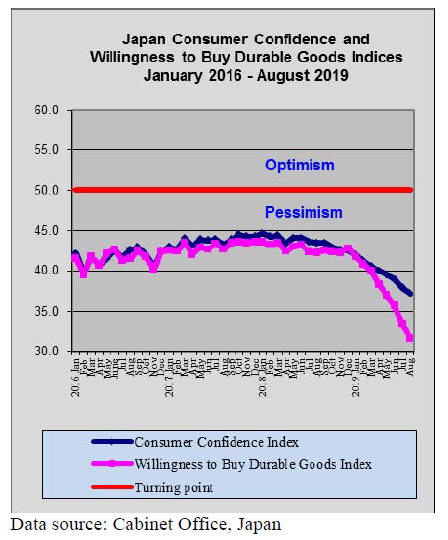
Rush to yen as global uncertainty rises
The flight to safety brought on by another series of US
tariff increases on Chinese exports caused a sharp
strengthening of the yen which rose to its highest level
against the US dollar since late 2016.
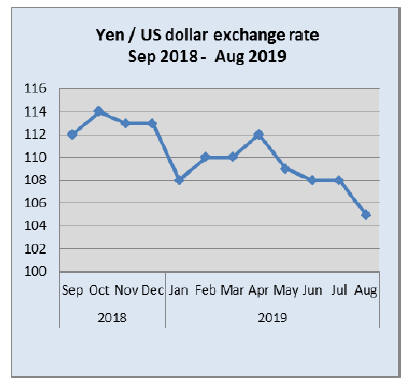
Housing starts down for 3 consecutive years
Over the past 3 years there has been a steady decline in
housing starts in Japan. Between 2017 and 2018 first half
year starts dipped 2% and there was a 3% decline between
2018 and 2019. Housing stars have dropped around 5%
over the past three years.
Residential building prices have started to fall according to
data from the Land Institute of Japan. The average price of
new condominiums in Tokyo dropped 1.65% y-o-y in the
second quarter of 2019, a sharp slowdown from growth of
almost 10% a year earlier.

July 2019 housing starts dropped 3% month on month
and
were down around 4% year on year.
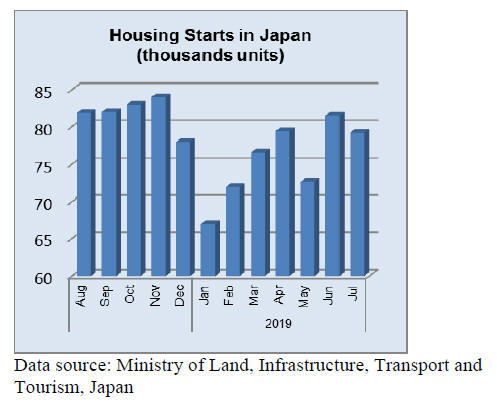
Import update
Furniture imports
The value of first half 2019 imports of wooden office
furniture HS 940330 were down around 14% compared to
the first half of 2018 and there was a slight year on year
dip in imports of wooden bedroom furniture in the first
half of 2019.
What stands out was the 12% increase in wooden kitchen
furniture in the first half of 2019 compared to the same
period in 2018. This rise in kitchen furniture imports
mirrors the steady increase in housing starts in Japan
which, except for May, have been rising since January this
year (see housing starts above).
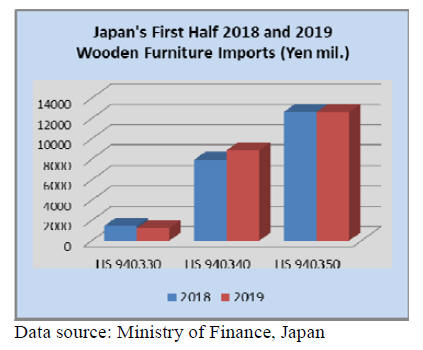
Office furniture imports (HS 940330)
Year on year, the value of June imports of wooden office
furniture declined 12% and month on month, June 2019
imports were down 19%.
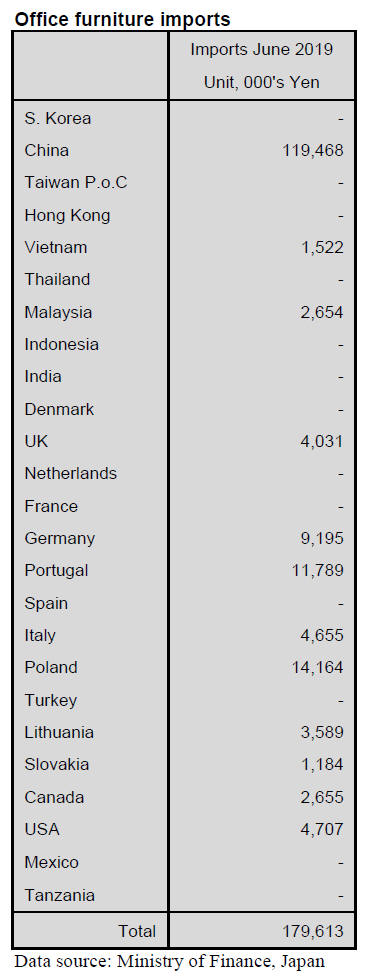
Building on the rise in shipments in May, the value
of
June shipments of wooden office furniture rose again in
June and accounted for around 66% of all Japan¡¯s wooden
furniture imports. China is the biggest supplier and the
other significant suppliers in June were Poland (8%) and
Portugal (7%). In total, shippers in the EU accounted for
just 28% of June imports.
Kitchen furniture imports (HS 940340)
Exporters in the Philippines and Vietnam maintained their
huge share grip of Japan¡¯s imports of wooden kitchen
furniture. In June exports from the Philippines edged
Vietnam into second place. However, both sources
dominate wooden kitchen furniture imports into Japan.
In June the Philippines accounted for 45% of Japan¡¯s
wooden kitchen furniture imports while Vietnam provided
another 39%. China is not a major shipper of wooden
kitchen furniture to Japan, supplying just 10% of June
import values. Exporters in Asia accounted for 96% of
Japan¡¯s wooden kitchen furniture imports in June.
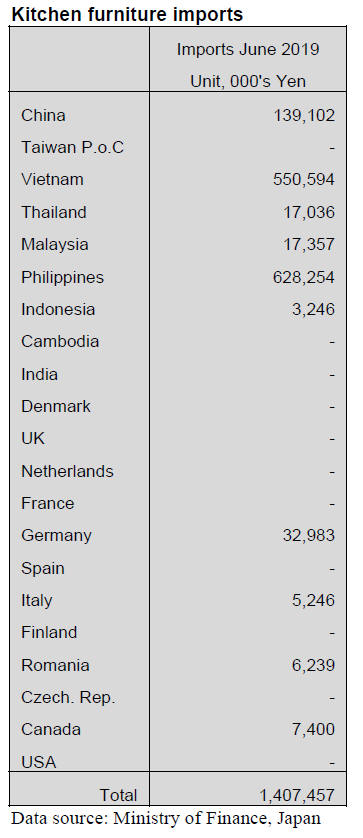
Bedroom furniture imports (HS 940350)
With Japan being a highly developed and quality
conscious market it is surprising that just 4% of bedroom
furniture imports are from the EU. Manufacturers in China
and Vietnam have successfully penetrated the Japanese
bedroom furniture market supplying almost 85% of all
Japan¡¯s June wooden bedroom furniture imports.
The year on year value of shipments of wooden bedroom
furniture was up 4% in June but, compared to a month
earlier, June arrivals were down 9%.

Trade news from the Japan Lumber Reports
(JLR)
The Japan Lumber Reports (JLR), a subscription trade
journal published every two weeks in English, is
generously allowing the ITTO Tropical Timber Market
Report to reproduce news on the Japanese market
precisely as it appears in the JLR.
For the JLR report please see:
http://www.nmokuzai.
com/modules/general/index.php?id=7
June plywood supply
Total supply in June was 476,200 cbms, 7.4% less than
June last year and 5.3% more than May. Production of
softwood plywood was 276,300 cbms, 1.6% more and
8.3% more, the highest record. Supply of imported
plywood was 189,900 cbms, 18.2% less and 1.8% more.
Domestic supply renewed record high after two new
plywood mills started in late May and the production by
these mills added on in June. The shipment of softwood
plywood was 270,200 cbms, 8.2% more and 2.4% more.
This is the second highest after last January. Since the
production exceeded the shipment, the inventories were
121,800 cbms, 6,800 cbms more than last month. Plywood
mills¡¯ inventories were only 0.4 month so hand-to-mouth
operation continues.
In imported plywood, Malaysian supply was 61,000 cbms,
23.5% less and 4.3% less. This is the lowest in last five
years. Indonesian supply was 70,700 cbms, 17.4% less and
22.8% more. China supplied 43,000 cbms, 7.7% less and
16.8% less. Because of sluggish market in Japan, the
importers have not placed much orders to the supply side
so future arrivals seem to continue low.
Plywood
There are two different pictures between domestic
plywood and imported plywood. Domestic softwood
plywood shipments continue very active and the
manufacturers continue a full production with low level
inventories.
Meantime, movement of imported plywood market
continues slow and high export prices and low market
prices in Japan continue.
Precutting plants secured enough orders from large house
builders so the operations keep busy. They need more
volume of softwood plywood to catch up orders.
Movement in distribution channels is slow.
Domestic manufacturers continue a full production but due
to high level shipments same as the production, they
are not able to build up the inventories so there are some
short items like thick panels, which delivery takes much
longer now.
Since the manufacturers have received enough orders for a
month, they are not able to accept any more order for
August. In this situation, plywood mills try to correct price
difference and bring the prices up to the proposed prices
after there were gaps between proposed prices and actual
market prices and the gap is gradually narrowing.
Movement of imported plywood varies by the area.
In Tokyo region, condo starts slowed down and many
redeveloping properties are in stage of interior finishing
and new properties will be next year so the demand for
imported plywood is slow. Meantime, in Kyushu and
Nagoya regions, condo starts are busy so that there is
ample demand for concrete forming panels but desired
prices by the contractors are severe.
By stagnating movement of imported plywood in Tokyo
market, the market prices continues depressed while the
suppliers export prices remain high. There are some short
items in the inventories so the dealers wish to place orders
but price gap between the suppliers and market in Japan is
too much so they are not able to place new orders.
Actually new orders dropped considerably since late last
year so arrivals of imported plywood in May and June
were less than 200,000 cbms, record low arrivals for two
straight months. There is no more congestion of bulk ships
so the inventories will decrease further more.
 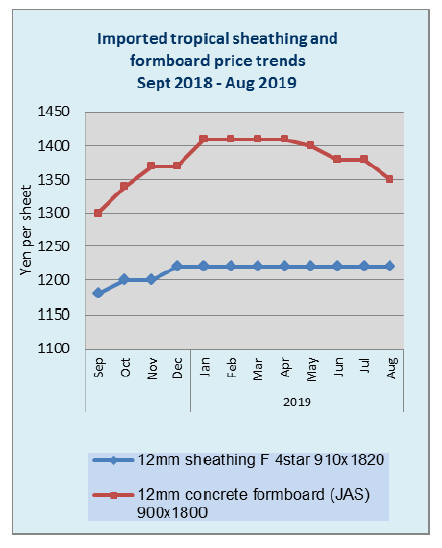
South Sea (tropical) logs and Lumber
Arrivals of PNG logs are steady. Log production in PNG
is dropping due to rainy season but plywood mills in
Japan carry ample log inventories so there is no fear of
supply shortage. Log demand by China and India is not
so active so the suppliers are not able to push the log
export prices up.
Log prices in Sarawak, Malaysia are softening by
improved log production but the prices of higher grade
logs Japan wants have very little influence.
Market prices of laminated free board from South East
Asian countries are s steady. Mercusii pine supply is
steady in Indonesia and the prices are the same as Chinese
red pine laminated board.
Orders for interior refurbishing of public facilities and
commercial shops got active before summer vacation,
which stimulated the demand. Interior works for building
to complete before the consumption tax increase will start
shortly so the demand should stay firm despite increased
supply.
Domestic logs and lumber
Due to prolonging rainy season, log production dropped in
July but the supply was ample in the first half of the
year so that sawmills¡¯ log inventory is full.
After log supply declined, post cutting cedar log prices are
firming and cypress log prices are also firm in Kyushu and
Chugoku region. August is the month with least log
production so log prices seem to stay firm through
September.
Lumber orders increased since last July by major
precutting plants. Orders on KD solid wood lumber, cedar
laminated lumber and cedar FJ stud are active. Meantime,
supply of 120 mm post, stud, sill and girder is excessive.
Market lumber prices are weak by oversupply with active
supply from sawmills. Also supply of imported Douglas
fir KD beam, hemlock sill, whitewood laminate post and
whitewood stud increased this year and the prices are
weakening, which influence domestic lumber market
Import of wood fuel for the first half.
Import of major wood fuel during the first six months of
this year is 750,319 ton of wood pellet, 56.7% more than
the same period of last year while PKS is 628,029 ton,
3.2% less.
Sources of wood pellet are Vietnam with 420,902 ton,
219.6% more, Canada with 266,806 ton, 19.4% less,
Australia with 29,255 ton, 211.6% more, Malaysia with
19,822 ton, 417.9% more. This is the first time that
Vietnam¡¯s volume exceeded Canadian as the demand to
use with coal burning increased.
Reasons that the Canadian volume dropped are Canadian
pellet manufacturing plant had some trouble then stop of
Keihin biomass power generation plant, which used
Canadian wood pellet mainly. Wood pellet from the U.S.A
is only 163 ton but there are several long term contracts
with large power plants, which will start up shortly so the
U.S. will be a major supplying country in coming years.
International wood pellet market is firming with recovery
of European demand but there is difference between long
term contracts and spot deals. Spot deals in the South East
Asia are soft after Korean demand decreased so the
Vietnamese pellet prices are on weak side.
Present prices for Japan market are holding at $130-140
per ton C&F. North American long term contract prices
are very firm since there are limited number of suppliers.
Demand for wood pellet in Japan seems to be firm but
large new power plants are looking for long term contracts
with South East Asian suppliers because North American
prices are high.
PKS import for the first half is almost the same as last
year. Sources are Malaysia with 131,455 ton, 31.3% less,
Indonesia with 496,280 ton, 8.6% more. FIT power plants
look for sustainable supply of PKS so the future is
uncertain.
|